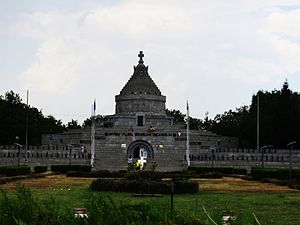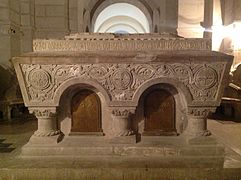Mausoleum of Mărășești
| Mausoleum of Mărășești | |
|---|---|
| Romania | |
 The Mausoleum of Mărășești | |
| For First World War Romanian dead and First World War Romanian missing, presumed dead. | |
| Unveiled | 18 September 1938 By King Carol II |
| Location | near |
| Designed by | George Cristinel and Constantin Pomponiu |
The Mausoleum of Mărășești is a memorial site in Romania containing remains of 5,073 Romanian soldiers and officers killed in the First World War and dedicated to the commemoration of the Battle of Mărășești and Romanian Army members who were killed during World War I.
The memorial took architects George Cristinel and Constantin Pomponiu 15 years to build and was unveiled on 18 September 1938 by King Carol II.
Background

The Battle of Mărășești, (August 6 to September 8, 1917) was a battle fought during World War I between Germany and Romania.
Before launching the attack, the battle was thought to be fought at Nămoloasa, and both sides were made up at that moment of a total of about 1 million soldiers. Field Marshal August von Mackensen launched an attack on August 6. The fighting lasted until September 8, when both sides ran out of fresh units. The German attempt to crush the last Romanian army led by General Eremia Grigorescu had failed, but the Romanians had not regained any more of their territory either.[1] The motto of the Romanian Army during the battle was "Pe aici nu se trece" (English: "They shall not pass"), probably inspired from the famous slogan of General Nivelle during the Battle of Verdun.
Romania lost over 27,000 men, including 610 officers, while Germany lost over 47,000 . Notably, the Romanian heroine Ecaterina Teodoroiu was killed at the end of this battle, on September 6, by machine-gun fire; two days later, Major General Karl von Wenninger was killed by artillery near the village of Muncelu, Străoane.
Gallery
See also
Notes
- ^ Cyril Falls, The Great War, p. 285
External links
45°52′19.927″N 27°12′28.746″E / 45.87220194°N 27.20798500°E











